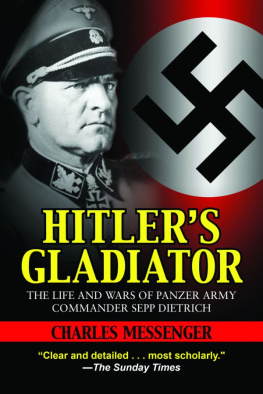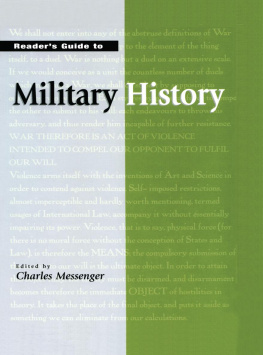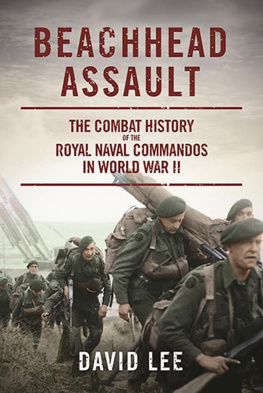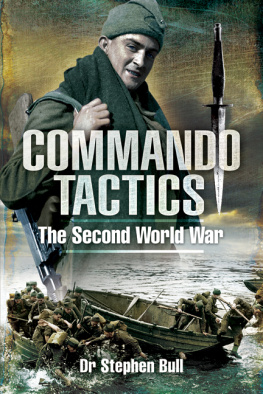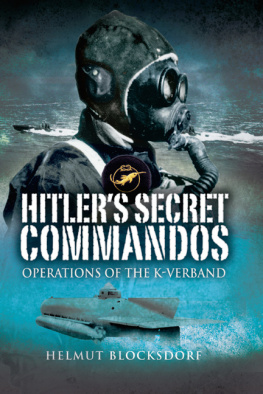William Collins
An imprint of HarperCollins Publishers
1 London Bridge Street
London SE1 9GF
www.WilliamCollinsBooks.com
First published in Great Britain by William Kimber & Co Ltd in 1985
Published by Grafton Books in 1991
This edition published by William Collins in 2015
Copyright Charles Messenger 1985
Charles Messenger asserts the moral right to be identified as the author of this work.
A catalogue record for this book is available from the British Library.
Cover image Imperial War Museum
All rights reserved under International and Pan-American Copyright Conventions. By payment of the required fees, you have been granted the non-exclusive, non-transferable right to access and read the text of this e-book on-screen. No part of this text may be reproduced, transmitted, down-loaded, decompiled, reverse engineered, or stored in or introduced into any information storage and retrieval system, in any form or by any means, whether electronic or mechanical, now known or hereinafter invented, without the express written permission of HarperCollins.
Source ISBN: 9780008168971
Ebook Edition January 2016 ISBN: 9780008168988
Version:2016-01-07
There have been many accounts written on the Commandos of the Second World War, both general and personal. Yet, there has never been what might be termed a definitive regimental or official history published. The closest to this was The Green Beret by Hilary St George Saunders, who had been the official Recorder at Combined Operations Headquarters. In his preface he made it clear that the book was not the official history, and, indeed, at the time he wrote it (it was published in 1949) he was forced to leave much unsaid for security reasons. Yet, even so, while he undoubtedly captured the Commando spirit, the book contains a numbers of errors of fact, which have unfortunately been perpetuated in some more recent works on the subject.
It was my publishers original intention that Commandos should be just an anthology. In order to gather the necessary material, I made contact with the Commando Association and was invited to attend one of the monthly meetings of the London Branch. The members quickly made it clear to me that they feared that I was embarking on something which would merely regurgitate all the old fallacies. It was this that prompted me to adopt a different approach and to concentrate on primary source material, which meant many hours of research in the Public Record Office, Royal Marines Museum, Imperial War Museum and other institutes. I then began to realise what they meant when I compared my findings to secondary works on the subject. Throughout all this time I maintained my contact with the Association, especially the London Branch, and the encouragement given to me spurred me on, even though at times I was daunted by the task I had set myself.
A major problem which I struck was how to draw up clear parameters, especially over the often blurred dividing line between Commandos per se and other Special Forces. In the end, I decided to concentrate on the Army and Royal Marine Commandos, and to merely give something of the origins and method of operating of other specialist units spawned by them and Combined Operations. I do hope, therefore, that former members of the Special Boat Section, Royal Navy Beachhead Commandos, Combined Operations Pilotage Parties and others will forgive me. If I had treated their exploits in the same detail, the result would have been a totally unwieldy book. A further problem I found was over the availability of records. In many cases they are fragmented and for a number of reasons. The pressures of war often gave little time for precise records to be made. Some also fell victim to post-war weeding, while others, especially if connected with the Special Operations Executive and No 30 Commando, remain classified to this day. In cases where I have not been able to substantiate a particular occurrence, I have so indicated with footnotes.
I make no apologies for the fact that I have retained something of the anthological approach. Not having been a Commando myself, let alone being old enough to have taken part in any of the momentous events described in this book, I have relied much on contemporary accounts and the often very clear memories of the ex-Commandos themselves. These have an authenticity which I could never hope to reproduce in my own words. Indeed, without the help of so many members of the Commando Association and other affiliated organisations, this book could not have been written, and it is to them and their comrades who have gone on before that I dedicate Commandos.
While to list the names of all who have helped me would take up almost a book in itself, there are a number who have given me particular assistance. In particular I would like to single out two individuals. Henry Brown MBE is, as the Secretary of the Commando Association since 1946, a household name among all ex-wartime Commandos. His constant advice and encouragement, as well as allowing me to quote from his wartime diary, have been invaluable to me. Likewise Lt Colonel Stephen Rose OBE, Hon Secretary of the Middle East Commandos Historical Research Group, opened up his complete archive on the early Middle East Commandos for me, and I spent a number of fascinating days at his house at Eastbourne with him. Without the benefit of this archive, the story of the Middle East Commandos could not have been told.
As for the others, there are a number of individuals at the Royal Marines Eastney to whom I am most grateful Major A.J. Donald RM (Corps Historical Officer), Major A.G. Brown MBE RM (Curator, RM Museum), Captain D.A. Oakley MBE RM, (Editor, Globe and Laurel), Bridget Spiers (Archivist) and Harry Playford (Photographic Librarian). Many thanks go too to Lt Colonel Sam Pope OBE RM for giving me the necessary introductions. The Editor Navy News kindly published a letter asking for former Commandos to get in touch with me, and James Ladd, himself the author of a number of books on the Commandos and Royal Marines, gave me some valuable leads. A number of Honorary Secretaries of subsidiary Commando Old Comrades groups were most helpful in putting me in touch with their members Norris Peak (43rd Royal Marines Commando Re-union), G. Jungle George Fagence (RN Commando Association) and Peter Jemmett (30 Commando Association). Clive Hughes of the Department of Documents, Imperial War Museum, produced a number of collections of papers held by the Museum, and the Staff of the Photographic Department were as helpful as they always are. I was also given further contacts by David Smurthwaite, Keeper of Books and Archives, National Army Museum, and John Harding of the Ministry of Defence (Army Historical Branch). Andrzej Suchcitz of the Polish Institute and Sikorski Museum, London, gave me much information on Polish Commandos, as did W. Boersma of the Airborne Museum at Arnhem on the Dutch Commandos. Likewise, I am most grateful to Christopher Woods CMG MC, SOE Adviser to the Foreign and Commonwealth Office, for throwing much light on the activities of the Small Scale Raiding Force (SSRF). In this connection, M.R.D. Foot, who served at Combined Operations HQ 194244, also helped by answering a number of my questions, as did Patrick Howarth and Mrs Margaret Prout. I am, too, especially grateful to Henrietta March-Phillipps, daughter of Gus, who commanded the SSRF, who gave me the benefit of the researches which she carried out on her father for a BBC Radio programme transmitted in 1972, and for allowing me to quote from the transcript. F.H. Lake of the Whitehall Library, Ministry of Defence, helped with his extensive knowledge of service wartime periodicals, and John Cloake CMG, biographer of Field Marshal Templer (to be published by Harrap in 1985), gave me some useful background to his subjects involvement with the V Corps School of Raiding. Vice Admiral Sir Peter Gretton KCB DSO OBE DSC very kindly lent me an account which he had written on 3 Commando Brigades operations in Burma, and Bryan Perrett also loaned me material on the 19th Lancers involvement in the Arakan. Terry Norman gave me biographical detail on the Congreve family. Rosemary Baker carried out much of the basic research at the Public Record Office. Lt Colonels George Forty and the late Ken Hill of the Tank Museum, Bovington, provided information on the SS Squadrons RAC. Cecilia Weston-Baker grappled with the typing of the manuscript with her usual cheerfulness and enthusiasm, and my thanks go too to Image Photographic of Shepherds Bush, London for their skill in reproducing many of the unique photographs included in the book.


